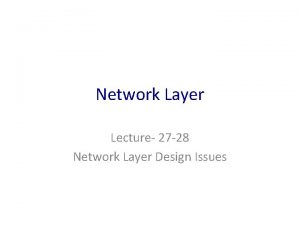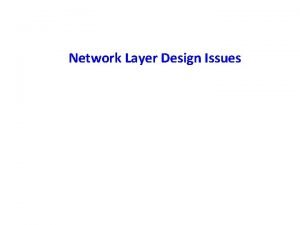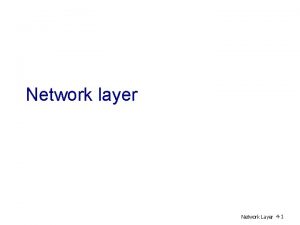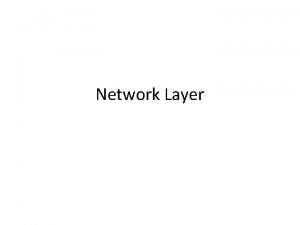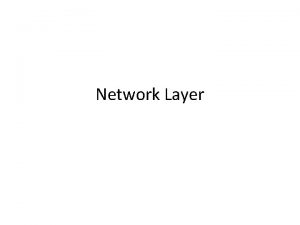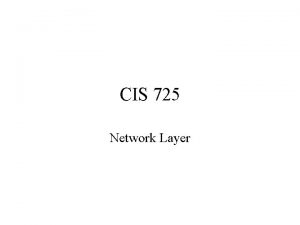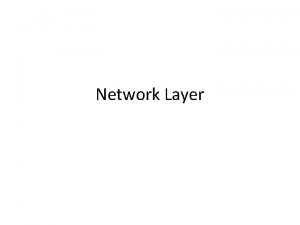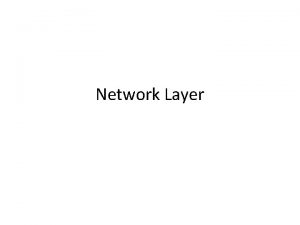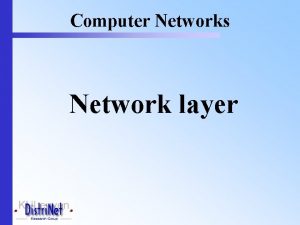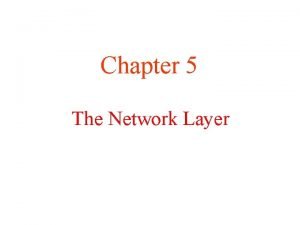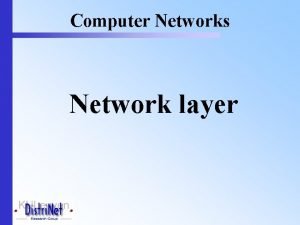Network Layer Lecture 27 28 Network Layer Design
















- Slides: 16

Network Layer Lecture- 27 -28 Network Layer Design Issues

• Concerned with getting packets from source to destination. • The network layer must know the topology of the subnet and choose appropriate paths through it. • When source and destination are in different networks, the network layer (IP) must deal with these differences. * Key issue: what service does the network layer provide to the transport layer (connection-oriented or connectionless).

Network Layer Design Goals 1. The services provided by the network layer should be independent of the subnet topology. 2. The Transport Layer should be shielded from the number, type and topology of the subnets present. 3. The network addresses available to the Transport Layer should use a uniform numbering plan (even across LANs and WANs).

With these goals in mind, two different types of service emerged: Connection oriented and connectionless. A connection-oriented service is one in which the user is given a "reliable" end to end connection. To communicate, the user requests a connection, then uses the connection to his hearts content, and then closes the connection. A telephone call is the classic example of a connection oriented service. In a connection-less service, the user simply bundles his information together, puts an address on it, and then sends it off, in the hope that it will reach its destination. There is no guarantee that the bundle will arrive. So - a connection less service is one reminiscent of the postal system. A letter is sent, that is, put in the post box. It is then in the "postal network" where it gets bounced around and hopefully will leave the network in the correct place, that is, in the addressee's letter box. We can never be totally sure that the letter will arrive, but we know that there is a high probability that it will, and so we place our trust in the postal network.

• With a connection oriented service, the user must pay for the length (ie the duration) of his connection. Usually this will involve a fixed start up fee. Now, if the user intends to send a constant stream of data down the line, this is great - he is given a reliable service for as long as he wants. However, say the user wished to send only a packet or two of data - now the cost of setting up the connection greatly overpowers the cost of sending that one packet. Consider also the case where the user wishes to send a packet once every 3 minutes. In a connection-oriented service, the line will thus be idle for the majority of the time, thus wasting bandwidth. So, connection-oriented services seem to be useful only when the user wishes to send a constant stream of data.

• One camp’s view ( Internet Community ) – With 30 Years of experience, In their view , the subnet is inherently unreliable, no matter how it is designed. Therefore, the hosts should accept the fact that the network is unreliable and do error control (i. e. , error detection and correction) and flow control themselves. So the network service should be connectionless. – The Internet offers connectionless network-layer service • The other camp’s view ( Telephone companies) – The subnet should provide a reliable , connection-oriented service. In this view, quality of service is the dominant factor, and without connections in the sub-net, quality of service is very difficult to achieve, esp-ecially for real-time traffic such as voice and video. – ATM networks offer connection-oriented network-layer service. –? – How Internet works when it runs over an ATM-based carrier provided subnet – Source host first establishes an ATM network layer connection to the destination host and then sends independent packets over it. (this approach is inefficient)

• Argument between connection oriented/connection less will lead to question – where to put complexity • In connection oriented – Complexity in Network Layer • In connection less – Complexity in Transport layer – User computing power is becoming cheap, therefore complexity for host can be increased

Messages Segments Transport layer Network service End system a Network layer Data link layer Data link End system layer b Physical layer

Machine A Machine B Application Transport Router/Gateway Internet Network Interface Network 1 Network 2

• We know of the two different classes of service offered by the network layer - connection oriented and connectionless. It is instructive now to see how these services are implemented within the network. • The two mechanisms used are • Virtual Circuits and Datagrams.

Datagram Packet Switching Packet 1 Packet 2

Virtual Circuit Packet Switching Packet

Inside the subnet, several trade-offs exist between virtual circuits and datagrams. • One trade-off is between router memory space and bandwidth. » Virtual circuits allow packets to contain circuit numbers instead of full destination addresses. If the packets tend to be fairly short, a full destination address in every packet may represent a significant amount of overhead and hence, wasted bandwidth. The price paid for using virtual circuits internally is the table space within the routers. Depending upon the relative cost of communication circuits versus router memory, one or the other may be cheaper.

• Another trade-off is setup time versus address parsing time. – Using virtual circuits requires a setup phase, which takes time and consumes resources. However, figuring out what to do with a data packet in a virtual-circuit subnet is easy: the router just uses the circuit number to index into a table to find out where the packet goes. In a datagram subnet, a more complicated lookup procedure is required to locate the entry for the destination.

• Virtual circuits have some advantages in guaranteeing quality of service and avoiding congestion within the subnet. • The loss of a communication line is fatal to virtual circuits using it but can be easily compensated for if datagrams are used. Datagrams also allow the routers to balance the traffic throughout the subnet, since routes can be changed partway through a long sequence of packet transmissions.

Routing…. . ? • Next Lecture
 01:640:244 lecture notes - lecture 15: plat, idah, farad
01:640:244 lecture notes - lecture 15: plat, idah, farad Network layer design
Network layer design The network layer is concerned with
The network layer is concerned with Network layer design issues
Network layer design issues Network layer design issues in computer networks
Network layer design issues in computer networks Ece 526
Ece 526 Fig 19
Fig 19 Parietal layer and visceral layer
Parietal layer and visceral layer Secure socket layer and transport layer security
Secure socket layer and transport layer security Presentation layer functions
Presentation layer functions Secure socket layer and transport layer security
Secure socket layer and transport layer security Secure socket layer and transport layer security
Secure socket layer and transport layer security Secure socket layer and transport layer security
Secure socket layer and transport layer security Layer 2 e layer 3
Layer 2 e layer 3 Layer-by-layer assembly
Layer-by-layer assembly Layer 2 vs layer 3 bitstream
Layer 2 vs layer 3 bitstream Graph neural network lecture
Graph neural network lecture

